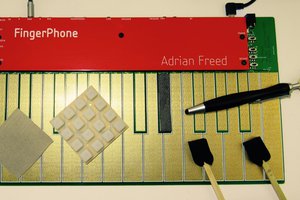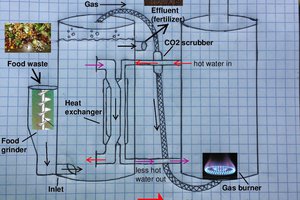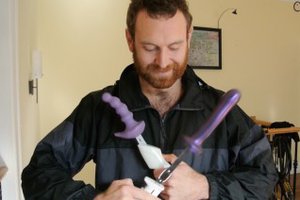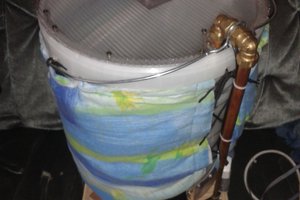Recipe
This recipe is a modified basic version of comes from a paper by Zhu et al-
Highly Anisotropic, Highly Transparent Wood Composites
Mingwei Zhu, Jianwei Song, Tian Li, Amy Gong, Yanbin Wang, Jiaqi Dai, Yonggang Yao, Wei Luo, Doug Henderson, and Liangbing Hu*
http://onlinelibrary.wiley.com/doi/10.1002/adma.20... or Sci-Hub to get more Open Access: http://onlinelibrary.wiley.com.sci-hub.cc/doi/10.1...
Basic Recipe
- Make a bath from 1 liter water, 100 grams of NaOH, 50 grams of Na2SO3.
- Put in wood and heat at a low temparature for 10 hours
- Drain bath, rinse wood with water
- Create new bath from 1 bottle of H2O2 and heat for 2 hours
- Rinse and preserve in Rubbing Alcohol
- Take wood from alcohol and place in epoxy
- Vacuum the epoxy through the wood 3 times over 30 minutes
- Let cure
Full Recipe
From their paper, here is their full recipe-
"Materials and Chemicals: Basswood from Walnut Hollow Company
was used in this study. The chemicals used in removing lignin contents
from wood were sodium hydroxide (>98%, Sigma-Aldrich), sodium sulphite (>98%, Sigma-Aldrich), and hydrogen peroxide (30% solution, EMD Millipore Corporation). The polymer used for infiltration was
epoxy resin (#300 resin and #21 nonblushing cycloaliphatic hardener,
AeroMarine Products, Inc.). The solvents used were ethanol alcohol
(190 proof, Pharmco-Aaper) and deionized (DI) water.
Lignin Removal from Wood: The lignin removal solution was prepared
by dissolving NaOH (2.5 mol L−1
The wood slices were immersed in the lignin removal solution and kept
boiling for 12 h, followed by rinsing in hot distilled water three times to
remove most of the chemicals. The wood blocks were then placed in
the bleaching solution (H2O2, 2.5 mol L−1
without stirring. When the yellow color of the sample disappeared, the
samples were removed and rinsed with cold water. The lignin-removed
samples were preserved in ethanol.
Polymer Infiltration: Epoxy resin was prepared by mixing the two liquid
components (#300 resin and #21 nonblushing cycloaliphatic hardener)
at a ratio of 2 to 1. Then the lignin-removed wood was placed at the
bottom of a dish and immersed in the liquid resin. The solution was
then degased under 200 Pa to remove the gas and ethanol solvent in
wood. Approximately 5 min later, the vacuum was released to let the
resin filling into wood structure by atmosphere pressure. The process
was repeated for three times. All the above processes were finished
within 30 min to avoid the polymer solidification. Finally, the dish
containing the wood sample and resin was kept static at 30 °C for 12 h.
The resin-infiltrated wood sample was peeled off from the dish after the
resin was completely solidified.
) and Na2SO3 (0.4 mol L−1)"
 blorgggg
blorgggg




 Adrian Freed
Adrian Freed
 Daniel
Daniel

 Morning.Star
Morning.Star
also, thinking about the epoxy filling the wood's "tube structures", I was wondering if we could "grow" fiber optics* in those ?
( nb: I can't get my hands on a post about a underwater living thing that has a very long thread going up that could be used as optic fiber , sorry :/ )
* or any other more transparent stuff that I don't know about ;)